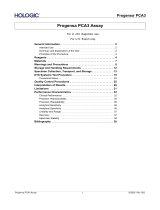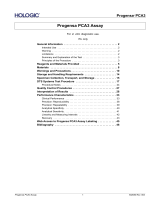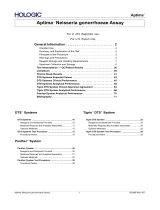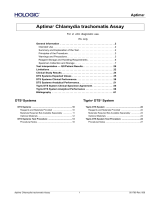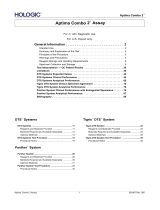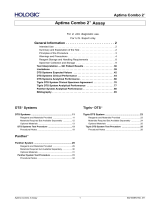Page is loading ...

Detection Reagent Kit
INTENDED USE
The reagents in the Detection Reagent Kit are used with tests according to the instructions outlined in the respective
package inserts and the Instrument Operator’s Manual.
REAGENTS AND MATERIALS PROVIDED
Hologic Detection Reagent Kit
Catalog No. 201791 1200 Tests
Detection Reagent I
0.1% Hydrogen Peroxide in 0.001 N Nitric Acid. 1 x 240 mL
Detection Reagent II
1 N Sodium Hydroxide. 1 x 240 mL
WARNINGS AND PRECAUTIONS
For in vitro diagnostic use.
Avoid contact of Detection Reagents I and II with skin, eyes, and mucous mem-branes. Wash with water if these
reagents come into contact with skin or eyes. If spills of these reagents occur, dilute with water and wipe dry.
STORAGE AND HANDLING REQUIREMENTS
The reagents contained in the Detection Reagent Kit are to be stored at 2° to 25°C and are stable until the date
stamped on the container. If the reagents freeze during shipping or storage, a precipitate may form. Heating the
reagents at 37° to 60°C facilitates dissolution of the precipitate. If heating is necessary, cool the reagents to room
temperature and thoroughly mix prior to use.
PROCEDURE
1. Remove the old Detection Reagents and empty lines using WASH protocol.
2. Invert bottles to thoroughly mix the contents of the new Detection Reagents.
3. Install the reagents in the instrument as outlined in the appropriate Operator’s Manual. For instruments which
require the use of secondary Detection Reagent reservoirs, refer to Operator’s Manual for instructions on
proper use of reservoirs.
PROCEDURAL NOTES
1. Ensure that all lines are primed with Detection Reagents prior to using the instrument.
2. Check the background count of newly transferred reagents when operating instruments requiring the use of
secondary Detection Reagent reservoirs. The mean background count should be below the specifications
listed in the Instrument Operator’s Manual.
3. If applicable, program the instrument software with the new volumes of the Detection Reagents.
Hologic, Inc.
10210 Genetic Center Drive
San Diego, CA 92121 USA
Customer Support: +1 844 Hologic (+1 844 465 6442)
customersupport@hologic.com
Technical Support: +1 888 484 4747
molecularsupport@hologic.com
For more contact information visit www.hologic.com.
2016 Hologic, Inc. All rights reserved.
102503 Rev. 001
/
